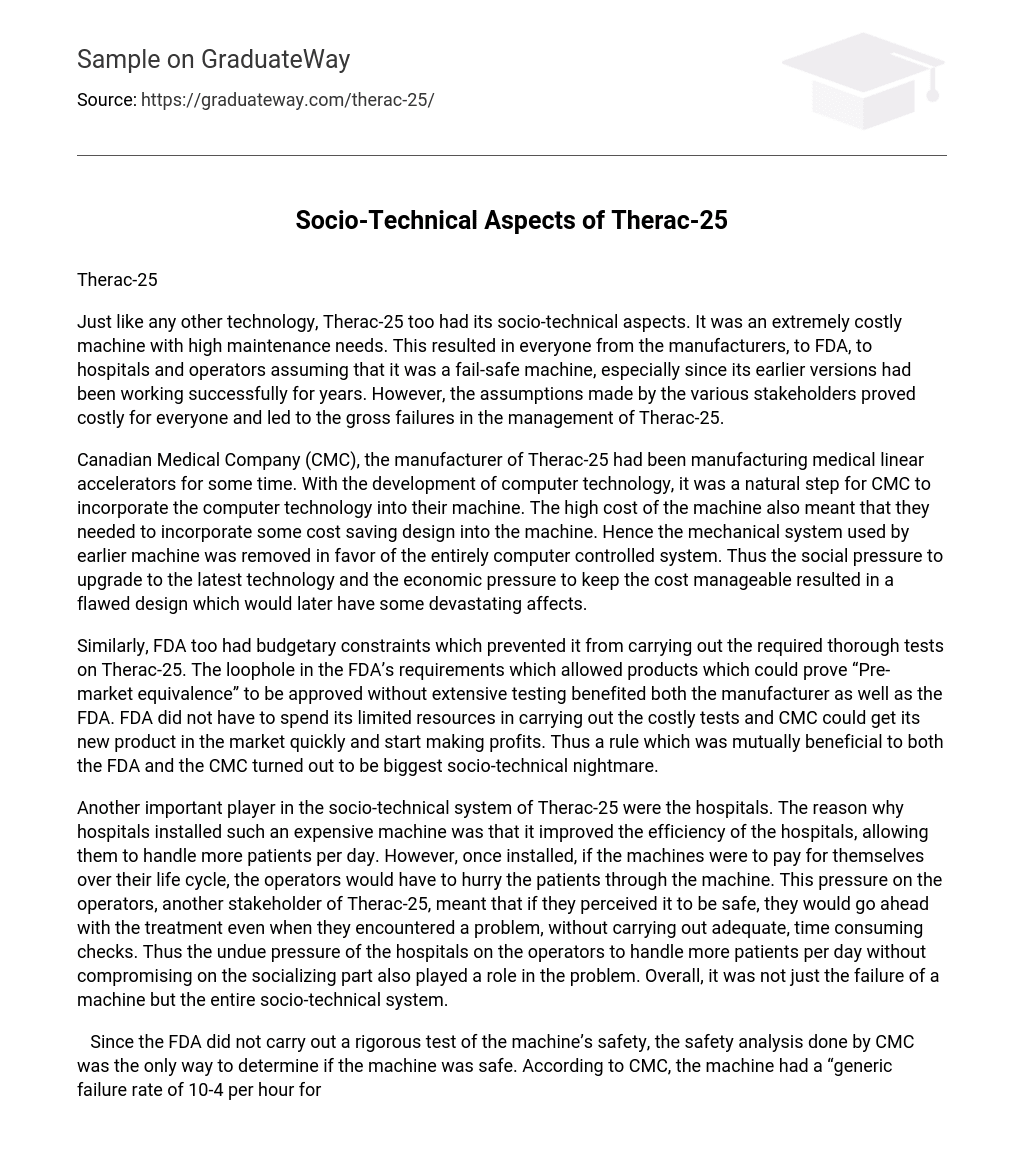Therac-25
Just like any other technology, Therac-25 too had its socio-technical aspects. It was an extremely costly machine with high maintenance needs. This resulted in everyone from the manufacturers, to FDA, to hospitals and operators assuming that it was a fail-safe machine, especially since its earlier versions had been working successfully for years. However, the assumptions made by the various stakeholders proved costly for everyone and led to the gross failures in the management of Therac-25.
Canadian Medical Company (CMC), the manufacturer of Therac-25 had been manufacturing medical linear accelerators for some time. With the development of computer technology, it was a natural step for CMC to incorporate the computer technology into their machine. The high cost of the machine also meant that they needed to incorporate some cost saving design into the machine. Hence the mechanical system used by earlier machine was removed in favor of the entirely computer controlled system. Thus the social pressure to upgrade to the latest technology and the economic pressure to keep the cost manageable resulted in a flawed design which would later have some devastating affects.
Similarly, FDA too had budgetary constraints which prevented it from carrying out the required thorough tests on Therac-25. The loophole in the FDA’s requirements which allowed products which could prove “Pre-market equivalence” to be approved without extensive testing benefited both the manufacturer as well as the FDA. FDA did not have to spend its limited resources in carrying out the costly tests and CMC could get its new product in the market quickly and start making profits. Thus a rule which was mutually beneficial to both the FDA and the CMC turned out to be biggest socio-technical nightmare.
Another important player in the socio-technical system of Therac-25 were the hospitals. The reason why hospitals installed such an expensive machine was that it improved the efficiency of the hospitals, allowing them to handle more patients per day. However, once installed, if the machines were to pay for themselves over their life cycle, the operators would have to hurry the patients through the machine. This pressure on the operators, another stakeholder of Therac-25, meant that if they perceived it to be safe, they would go ahead with the treatment even when they encountered a problem, without carrying out adequate, time consuming checks. Thus the undue pressure of the hospitals on the operators to handle more patients per day without compromising on the socializing part also played a role in the problem. Overall, it was not just the failure of a machine but the entire socio-technical system.
Since the FDA did not carry out a rigorous test of the machine’s safety, the safety analysis done by CMC was the only way to determine if the machine was safe. According to CMC, the machine had a “generic failure rate of 10-4 per hour for software events”. As pointed out by Leveson (1993), such a figure cannot justify every type of “software error or software behavior.” In fact, Therac-25 had so many software problems that it was common place for the machine to give malfunction message. These malfunction problems were so common that operators had become “insensitive to machine just as malfunctions” (Leveson).
The FDA rules in 1980s were also extremely lax and questionable. A machine which had an entirely new software system was allowed to enter market by the FDA on grounds that it was “pre-market equivalent” just like 94% of medical devices in 1984. Since most safety mechanisms had been moved to software, the “pre-market equivalent) declaration was an extremely optimistic one. (Therac-25 history). Several other FDA rules of the time were similarly unacceptable. The manufacturers, rather than the users, of the medical device were required to report a problem. And to top it, if there was a serious problem with a machine, the FDA had no authority to recall it and was left negotiating with the manufacturer.
The role of the hospitals in managing Therac-25 was also not without problems. In one of the first accidents at Kennestone Regional Oncology Center, the hospital informed neither the manufacturer nor the FDA. Even though the hospitals were not required by law to report such accidents to the FDA, proper reporting could have prevented future accidents. Also the hospitals put immense pressure on the operators to push large numbers of patients through treatment despite the associated dangers (operator interview).
As far as the operators are concerned, the biggest problem they faced was the lack of proper training. There was no standard industry-wide certification or education for operators. And even though The American Registry of Radiologic Technologists has a test to license the operators, many states do not require hospitals to hire licensed technicians. The operators may be extremely careful and conscientious of the patient’s health but the lack of proper training is an invitation to accidents. And in all this confusion, the most important stakeholder, the patients, suffers the most.
As it turns out, the Therac-25 accidents were the result of a gross failure of the socio-technical system around the machine. The main problem was with the machine’s software, which was not caught by CMC’s safety analysis and allowed to get into the market by FDA. The high pressure by the hospitals and the reassurance by CMC about the perfection of their machine meant that operators skipped visual checks. And all this compounded resulting in one of the more serious medical accidents.
Works Cited
N. Leveson, C. Turner, “An Investigation of the Therac-25 Accidents,” In Ethics and Computing: Living Responsibly in a Computerized World, by K. W. Bowyer. Los Alamitos, CA: IEEE Computer Society Press, 1996. First Published in Computer, Vol. 26. No. 7, July 1993, pp. 18-41.
“A History of the introduction and Shut down of Therac-25”. Computingcases.org. Retrieved from http://computingcases.org/case_materials/therac/case_history/Case%20History.html
“Summary of operator interview”. Computingcases.org. Retrieved from http://computingcases.org/case_materials/therac/supporting_docs/operator_interview/therac_hospital.html





